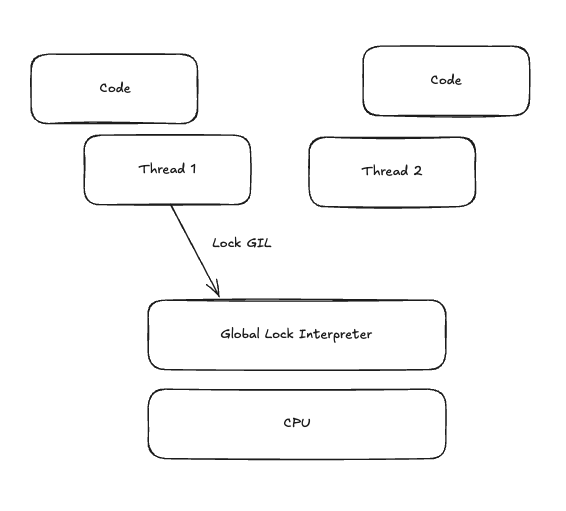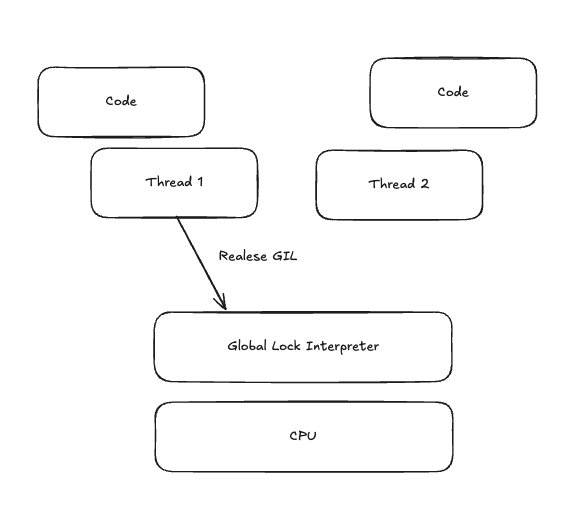What is Python GIL? How it works?
Things you should know before reading this article:
- What is Parallelism?
- What is Concurrency?
- What is a Deadlock?
- What is Race Concurrency?
- What is a Process?
- What is a Thread?
Introduction
The Global Interpreter Lock, is a lock that protects access to Python objects and carefully controls thread execution, preventing race concurrency in data access and modification, ensuring that only one thread can execute Python code at a time.
Without the GIL, Python’s memory management can be not thread-safe, it could lead to inconsistencies and crashes. (Deadlocks)
2 - How it works?
It's very simple, Thread will hold the GIL when it is running, and after running the Thread will release the GIL. The next threads must request access to the GIL in order to execute Opcodes (low-level operations). I draw one example of GIL behavior below:
- Moment 1:

- Moment 2:

- Moment 3:

It means that Python developers can utilize async code, and multi-threaded code and never have to worry about acquiring locks on any variables in the process running or having processes crash from deadlocks.
3 - Pros of using GIL:
- It simplifies the implementation of CPython's memory management, avoiding race conditions.
- This mechanism ensures that Python's core data structures, like dictionaries and lists, are thread-safe without requiring complex locking mechanisms.
- The GIL makes it easier to integrate C extensions with Python and allows the use of CPython, the most common interpreter and compiler used by the community.
4 - Cons of using GIL:
- The most significant drawback of the GIL is that it prevents Python programs from taking full advantage of multi-core CPUs using multi-threading.
- In CPU-bound applications, the GIL can become a significant bottleneck, as it prevents true parallel execution of threads
- As Developer, you may face challenges when trying to optimize multi-threaded Python programs.
5 - How to Deal With GIL Cons?
Instead of using threads, you can use processes to run your algorithms in some cases. For IO/Bound operations Threading and concurrency can allow you to have a better use of your resources, for CPU/Bound operations you can use the multiprocessing library to better resource use.
The above is the detailed content of What is Python GIL? How it works?. For more information, please follow other related articles on the PHP Chinese website!

Hot AI Tools

Undresser.AI Undress
AI-powered app for creating realistic nude photos

AI Clothes Remover
Online AI tool for removing clothes from photos.

Undress AI Tool
Undress images for free

Clothoff.io
AI clothes remover

AI Hentai Generator
Generate AI Hentai for free.

Hot Article

Hot Tools

Notepad++7.3.1
Easy-to-use and free code editor

SublimeText3 Chinese version
Chinese version, very easy to use

Zend Studio 13.0.1
Powerful PHP integrated development environment

Dreamweaver CS6
Visual web development tools

SublimeText3 Mac version
God-level code editing software (SublimeText3)

Hot Topics
 1377
1377
 52
52
 How to solve the permissions problem encountered when viewing Python version in Linux terminal?
Apr 01, 2025 pm 05:09 PM
How to solve the permissions problem encountered when viewing Python version in Linux terminal?
Apr 01, 2025 pm 05:09 PM
Solution to permission issues when viewing Python version in Linux terminal When you try to view Python version in Linux terminal, enter python...
 How to efficiently copy the entire column of one DataFrame into another DataFrame with different structures in Python?
Apr 01, 2025 pm 11:15 PM
How to efficiently copy the entire column of one DataFrame into another DataFrame with different structures in Python?
Apr 01, 2025 pm 11:15 PM
When using Python's pandas library, how to copy whole columns between two DataFrames with different structures is a common problem. Suppose we have two Dats...
 How to teach computer novice programming basics in project and problem-driven methods within 10 hours?
Apr 02, 2025 am 07:18 AM
How to teach computer novice programming basics in project and problem-driven methods within 10 hours?
Apr 02, 2025 am 07:18 AM
How to teach computer novice programming basics within 10 hours? If you only have 10 hours to teach computer novice some programming knowledge, what would you choose to teach...
 How does Uvicorn continuously listen for HTTP requests without serving_forever()?
Apr 01, 2025 pm 10:51 PM
How does Uvicorn continuously listen for HTTP requests without serving_forever()?
Apr 01, 2025 pm 10:51 PM
How does Uvicorn continuously listen for HTTP requests? Uvicorn is a lightweight web server based on ASGI. One of its core functions is to listen for HTTP requests and proceed...
 How to dynamically create an object through a string and call its methods in Python?
Apr 01, 2025 pm 11:18 PM
How to dynamically create an object through a string and call its methods in Python?
Apr 01, 2025 pm 11:18 PM
In Python, how to dynamically create an object through a string and call its methods? This is a common programming requirement, especially if it needs to be configured or run...
 What are some popular Python libraries and their uses?
Mar 21, 2025 pm 06:46 PM
What are some popular Python libraries and their uses?
Mar 21, 2025 pm 06:46 PM
The article discusses popular Python libraries like NumPy, Pandas, Matplotlib, Scikit-learn, TensorFlow, Django, Flask, and Requests, detailing their uses in scientific computing, data analysis, visualization, machine learning, web development, and H
 How to avoid being detected by the browser when using Fiddler Everywhere for man-in-the-middle reading?
Apr 02, 2025 am 07:15 AM
How to avoid being detected by the browser when using Fiddler Everywhere for man-in-the-middle reading?
Apr 02, 2025 am 07:15 AM
How to avoid being detected when using FiddlerEverywhere for man-in-the-middle readings When you use FiddlerEverywhere...
 How to handle comma-separated list query parameters in FastAPI?
Apr 02, 2025 am 06:51 AM
How to handle comma-separated list query parameters in FastAPI?
Apr 02, 2025 am 06:51 AM
Fastapi ...




